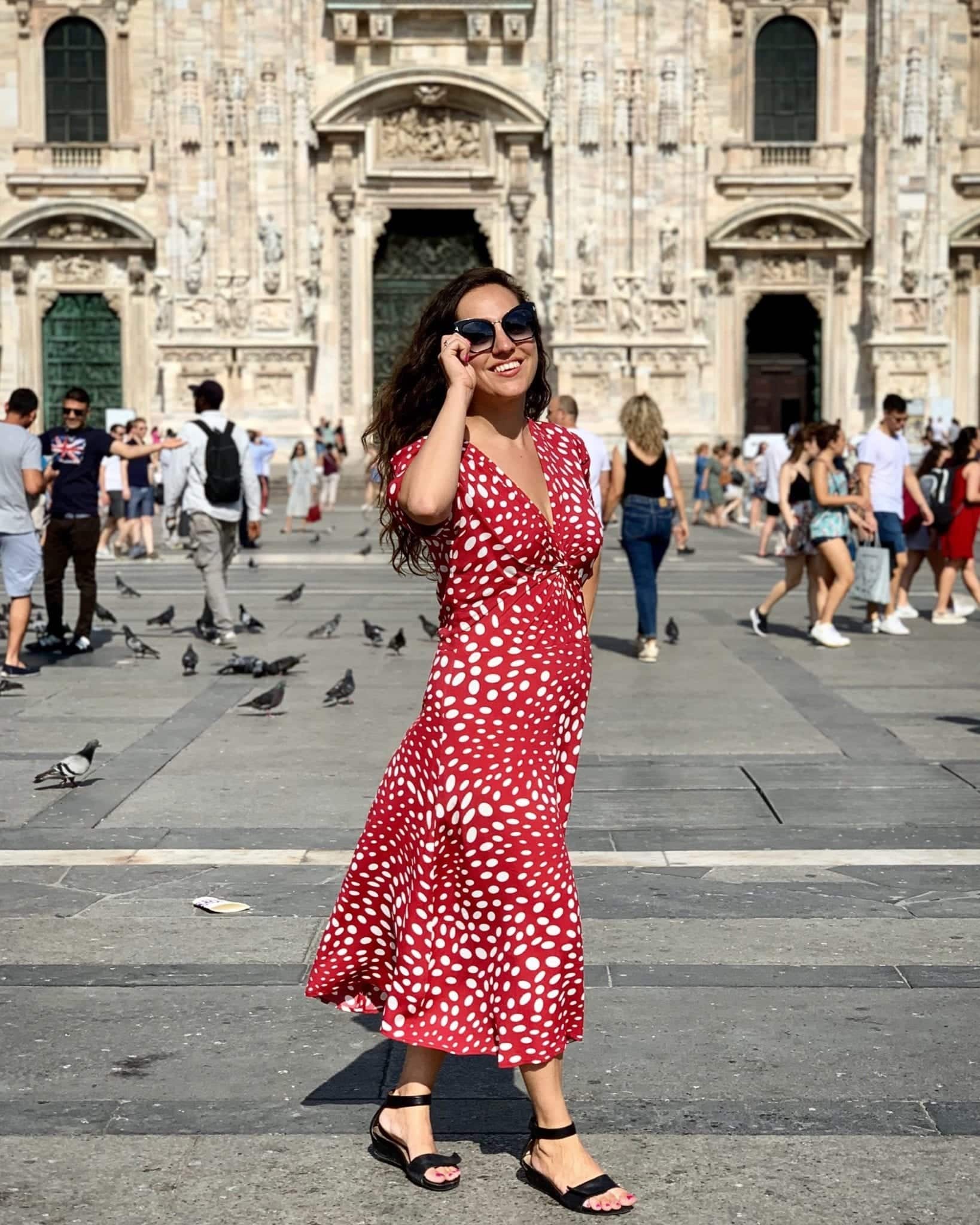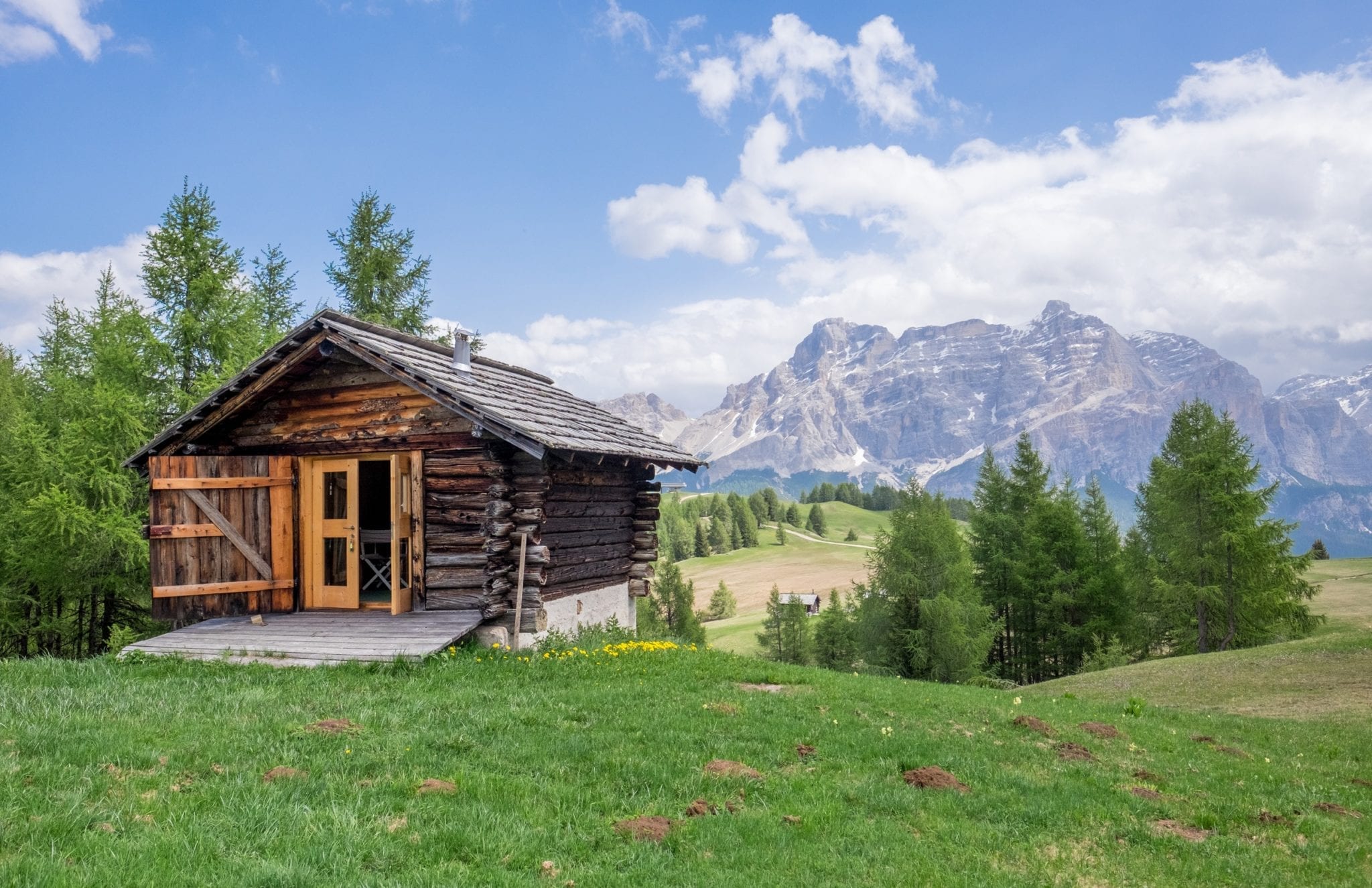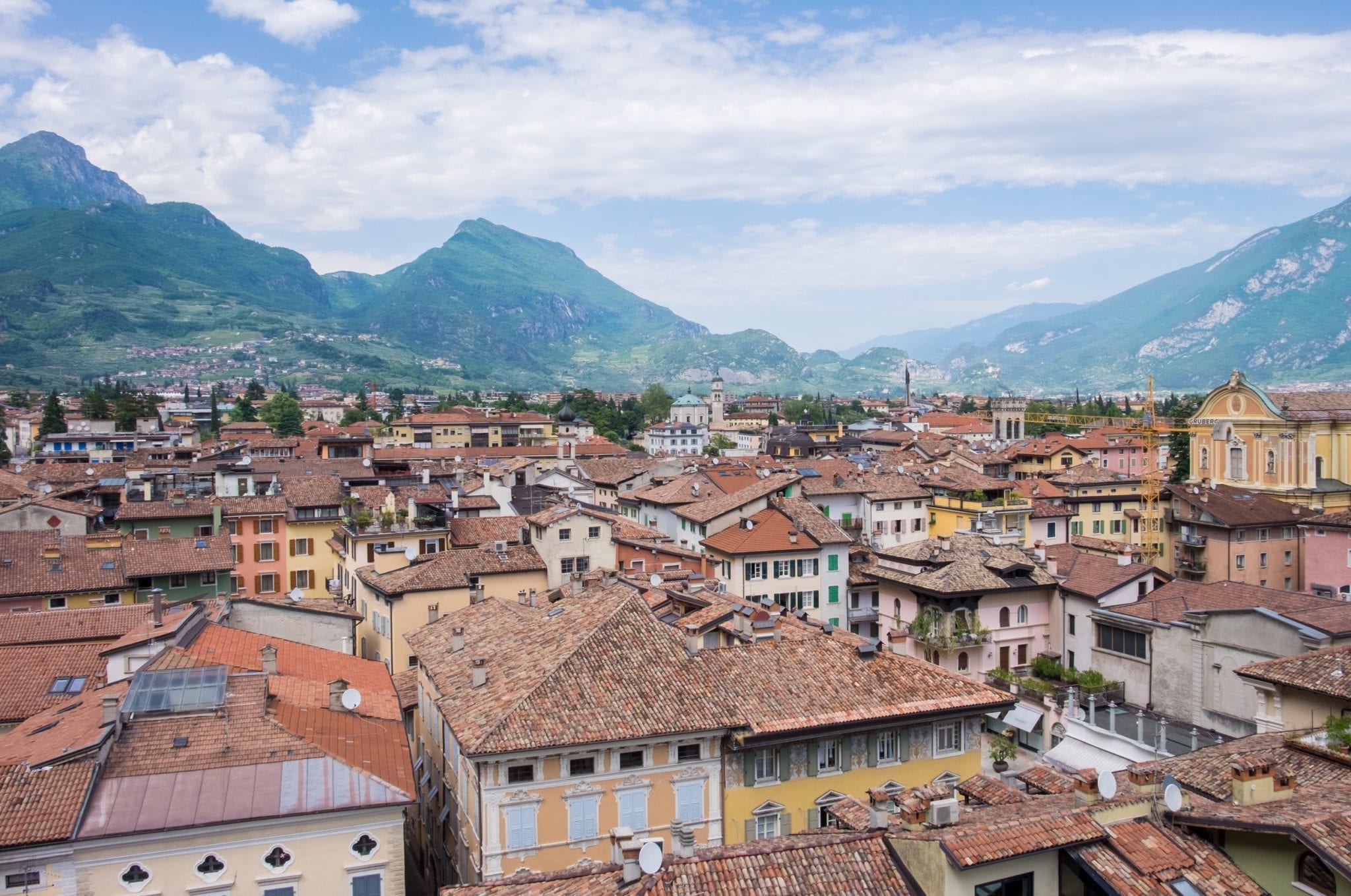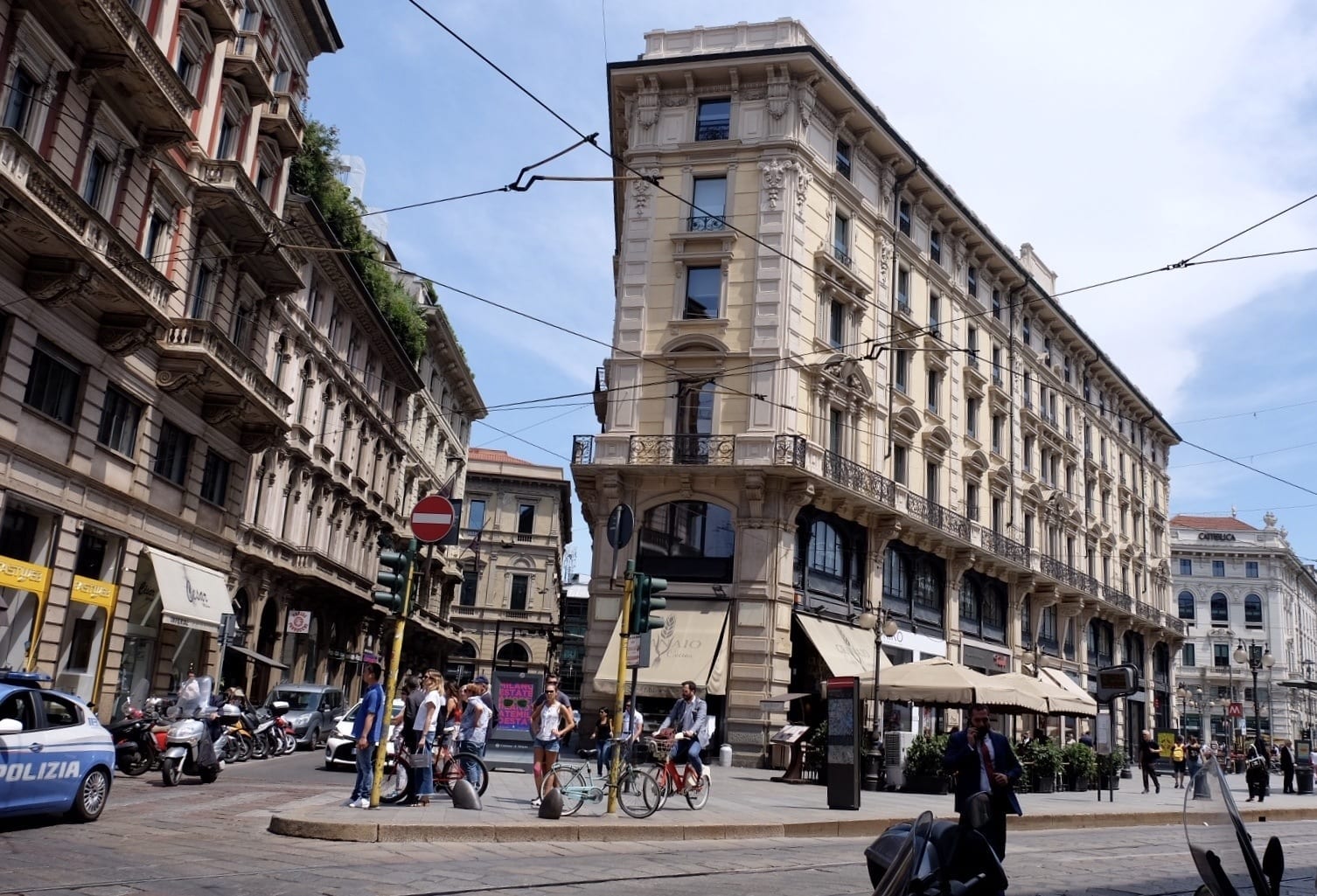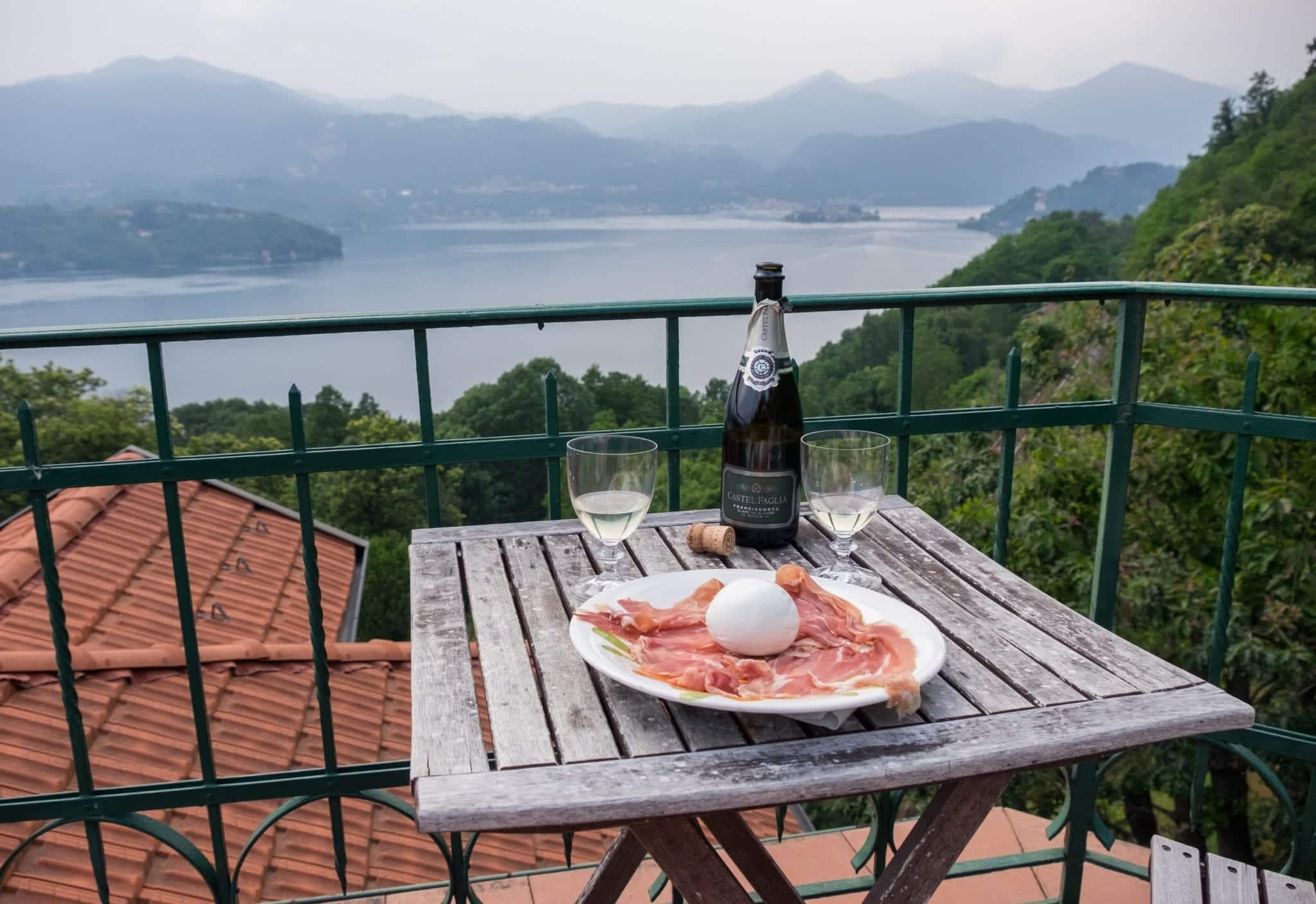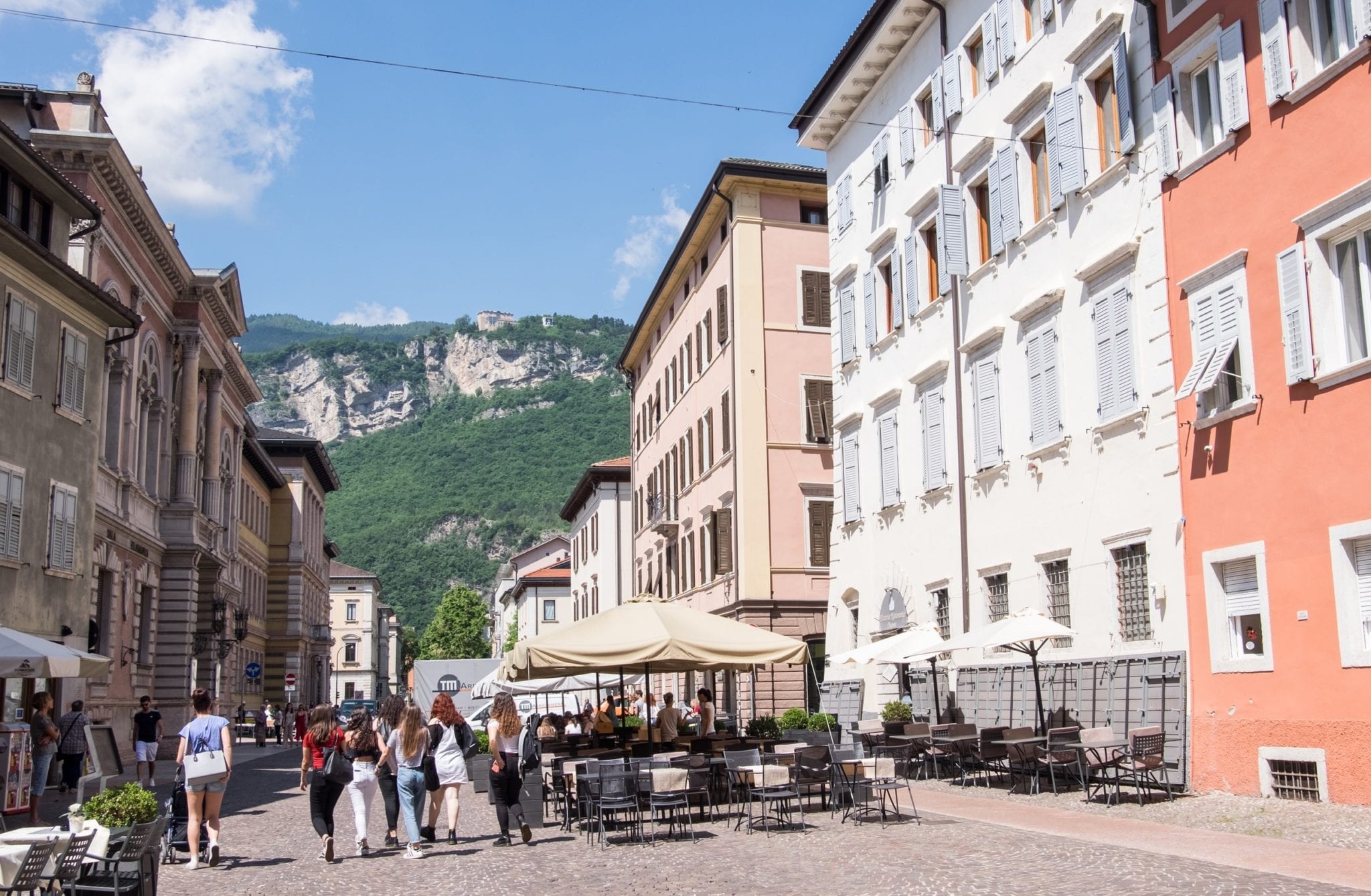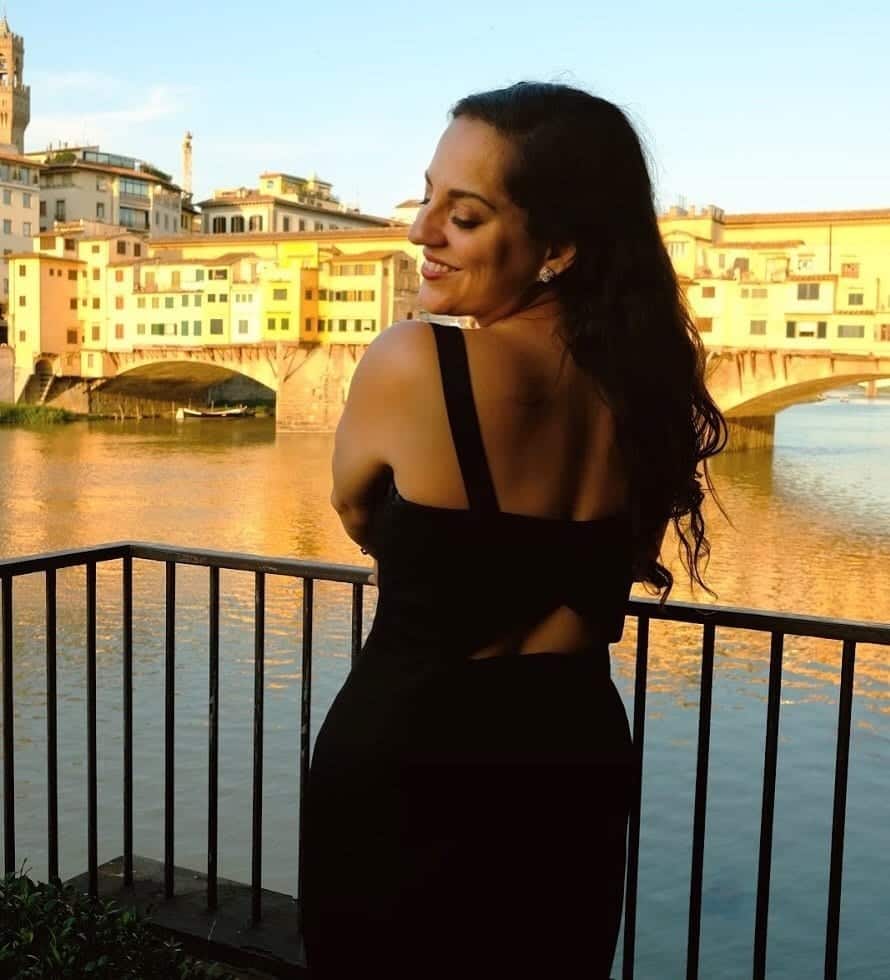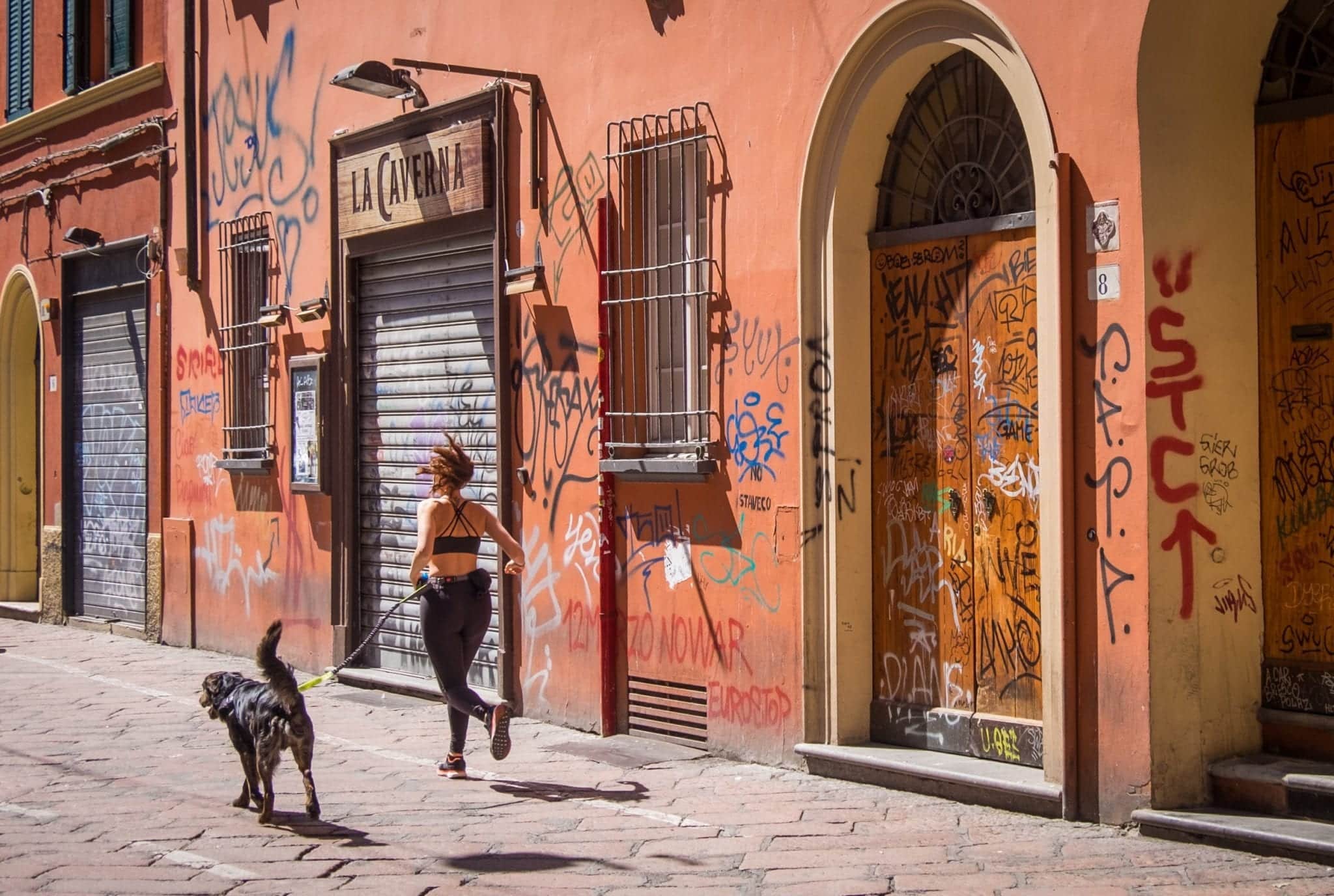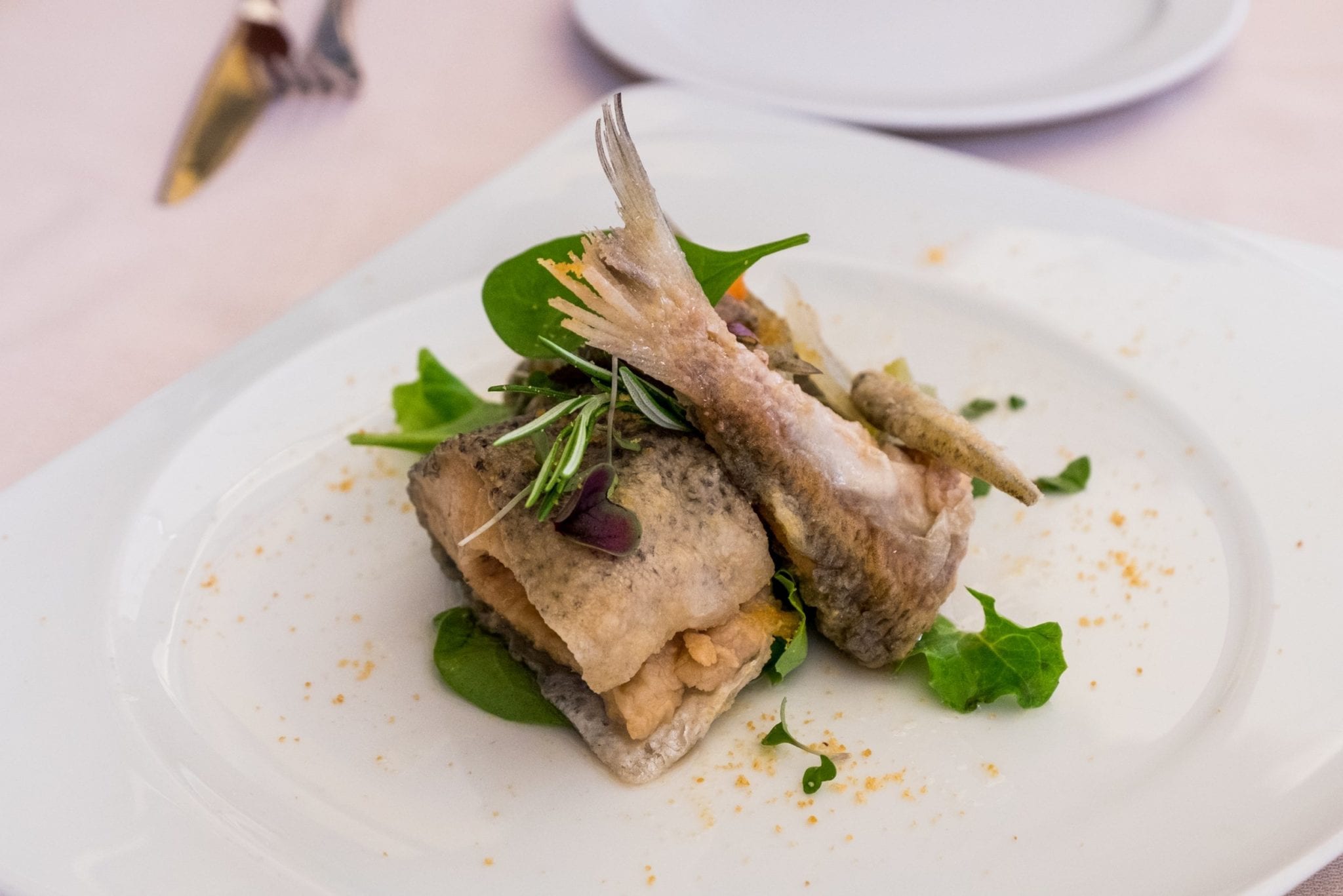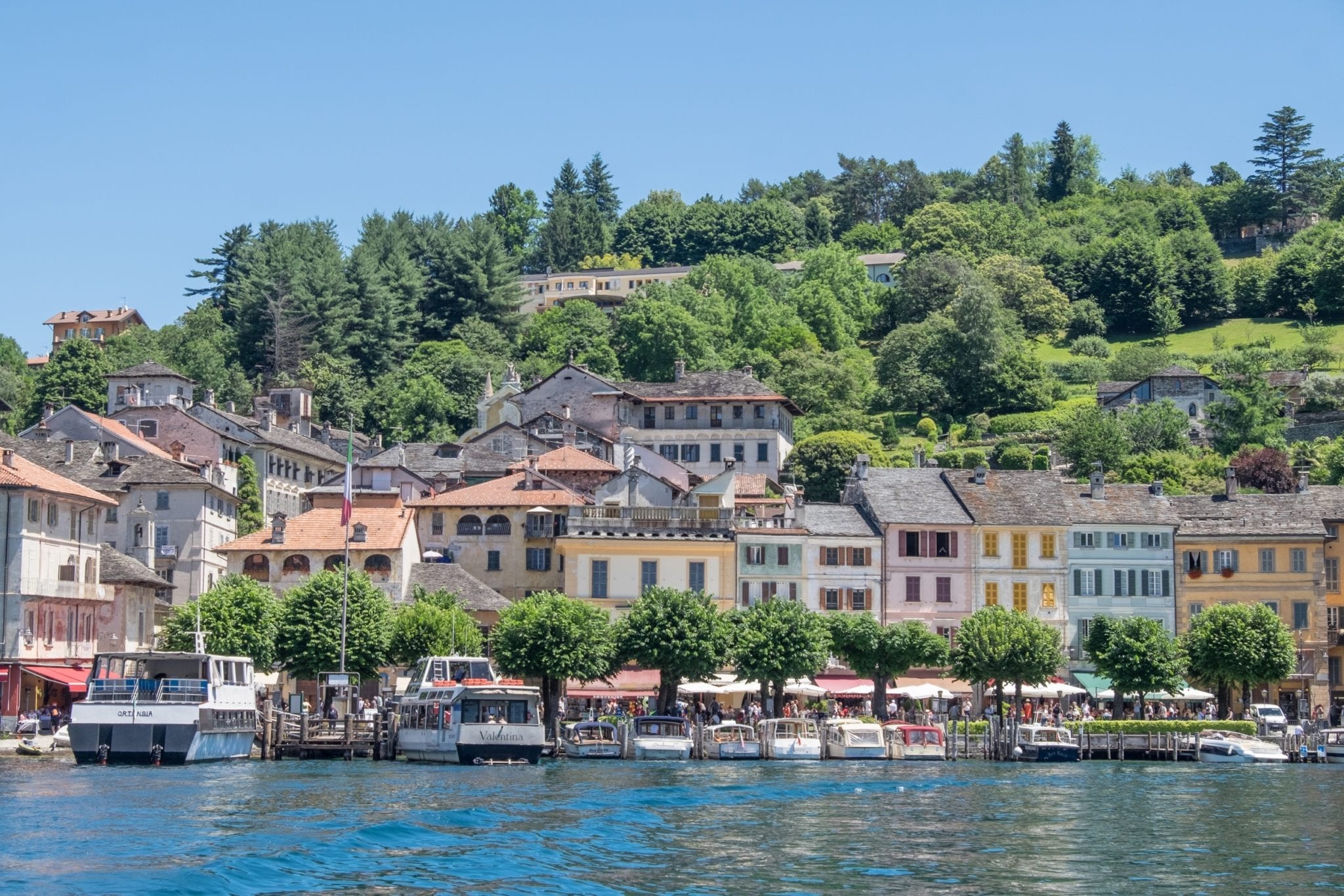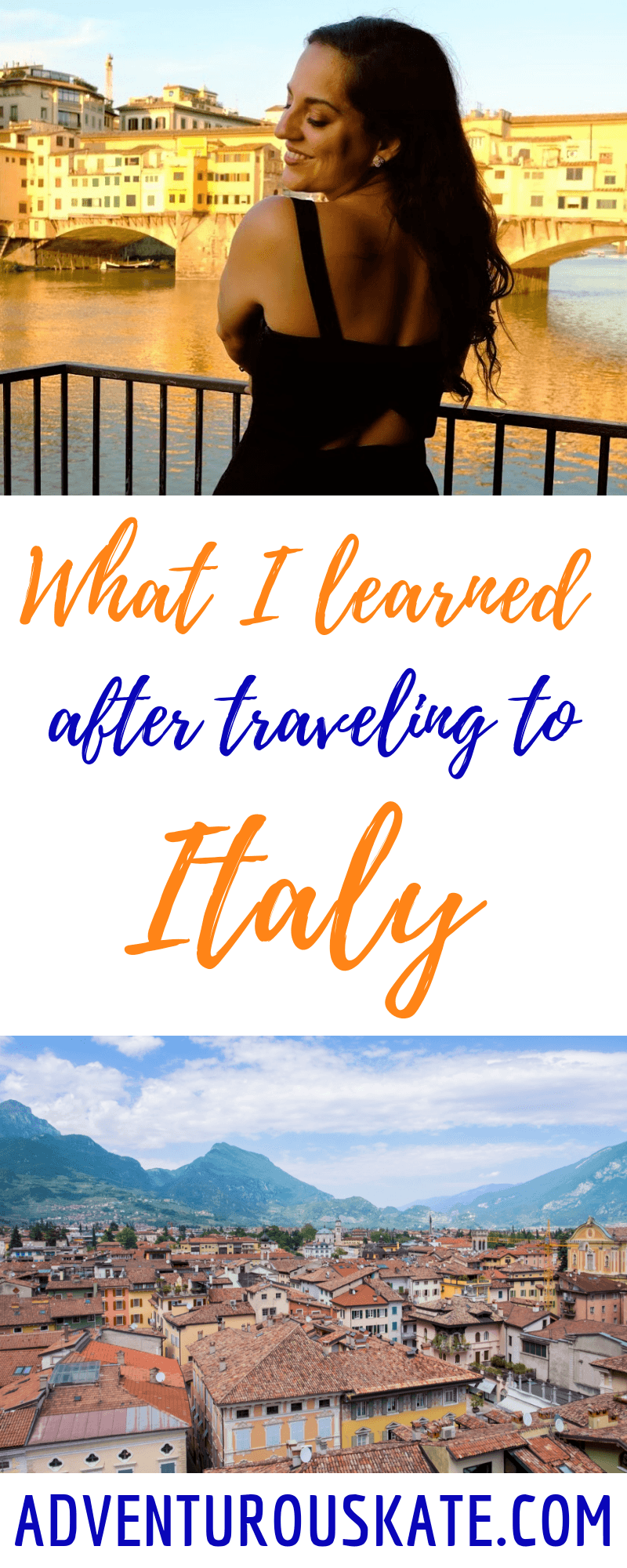Adventurous Kate contains affiliate links. If you make a purchase through these links, I will earn a commission at no extra cost to you. Thanks!
There are few countries that I know better or more intimately than Italy. I visit Italy as often as I can, and while this country is forever in my top five favorite countries, it just might be my favorite (!).
It’s easy to put Italy in a box, to treat it all the same. To say that Italy is nothing but people talking with their hands and gelato on every corner.
I’ve learned a lot over the years. That the best (and cheapest) way to consume coffee is standing at a counter. That Italians spend money on quality clothing and accessories. That the sign of a good gelato shop is muted colors in metal tins. That you cover your shoulders and knees in churches. That “permesso” is the snobbiest way of saying “excuse me.” That aperitivos give you an unlimited buffet for the cost of a drink.
But I’m always learning more. And this is what I learned on my latest trip.
Sicily is not the most different region in Italy — Alto Adige is.
When I first visited Sicily in 2015, it felt like I was a different world. Sicily was like Italy turned upside down — a place where the local dialect was indecipherable and the act of driving was like taking your life in your own hands.
READ MORE:
The Joys and Challenges of Traveling in Sicily
But Alto Adige is truly another world.
Also known as South Tyrol, Alto Adige is a region in northeast Italy that has been volleyed back and forth between Italy and Austria over the centuries. Today, every town has both an Italian and German name — Bolzano is Bozen, Bressanone is Brixen, La Vila is Stern (?!). Even so, neither Italian nor German is the local language: Ladin is, and today it’s spoken by about 20,000 people, though each valley has its own dialect and accent!
Drive around Alto Adige and you’ll think you’re in the Swiss or Austrian Alps. The cuisine reflects this too — you won’t be served bufala mozzarella here. Expect hearty dishes like pressknödel, bread and cheese dumplings, the kind of fare that will keep you warm through mountain winters. And the speck, a soft smoky prosciutto, is beyond scrumptious.
Driving through Alto Adige, you just might forget you’re in Italy.
Looking for untouristed Italy? Head to Trentino.
So many people visit Italy for the first time and hit up Rome, Florence, Venice, and either Cinque Terre or the Amalfi Coast, then get home and exclaim that Italy would have been perfect if it wasn’t just so damn crowded.
Yeah — it was super-crowded because you went to the most touristy spots. But the vast majority of Italy is not like that. There are so many undertouristed parts where you can enjoy the best of Italy without the crowds.
When I heard last year that Visit Trentino was sponsoring the Traverse conference, I was equally thrilled (yay, a conference somewhere other than Germany or the UK!) and intrigued. I knew tons about Italy but nothing about Trentino.
Well, I should have. As we drove into the region, mountains rose up all around us and vineyards spilled out beneath them. We based in the city of Trento, full of pastel buildings covered with frescoes. And just a short drive from the city you can climb those mountains, check out an art museum in Rovereto, or take in the lakeside at Riva del Garda. Oh, and the local TrentoDOC wine is fantastic.
Trentino is one of the most scenic parts of Italy that I’ve seen — and I’m stunned that more people don’t visit. You should head there soon.
Italian cities vary more than you think.
It’s easy to paint all Italian cities with the same brush — to say that they’re all filled with impossibly fashionable people with perfect hair and clothes. But the longer you travel in Italy, the more you realize that there is a lot of nuance to that.
Take two of the cities I visited on this trip: Milan and Trento. Milan is arguably the most cosmopolitan city in Italy; only Rome can compare. And even though I live in New York, a very fashionable city, I felt ridiculously unfashionable in Milan! One night I went out for an aperitivo on Corso Garibadi, a trendy area, and I was nearly knocked sideways by how well everyone was dressed. Especially the men. So many perfectly tailored suits and haircuts without a strand out of place.
Trento, by contrast, is a much smaller city — it felt a lot more like southern Italy to me. Not a lot of people dressed up; it felt more casual by comparison. Rather than perfect haircuts, there were a lot of mullets in town. It felt a lot like comparing Trento to Milan was like comparing a small southern or midwestern city to New York.
At one point, a friend who grew up in Bologna told me that when he first moved to Milan, he was stunned that there were Chinese people speaking Italian with a Milanese accent. That was close-minded of him, he pointed out, but that was just how he grew up. Even in a city as large as Bologna, it had nowhere near the diversity of Milan.
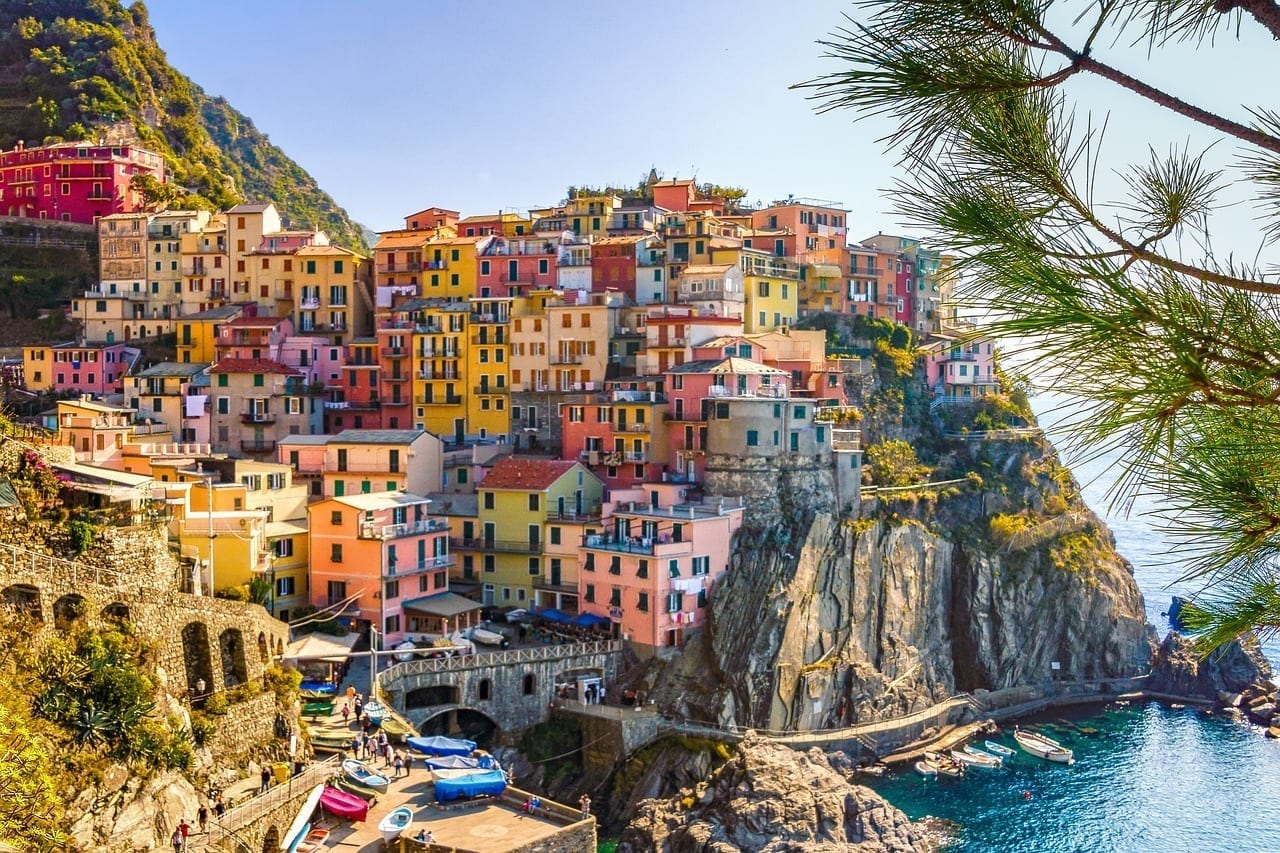
I still have zero desire to visit Cinque Terre.
Cinque Terre is probably my biggest oversight in Italy. It seems like everyone has visited this collection of beautiful seaside cities. Somehow I missed it over the years, starting when all eight of my roommates went one weekend in Florence — but I honestly don’t care.
Cinque Terre is being strongly impacted by overtourism at the moment. The villages are precariously perched on the edge of the sea, they’ve faced damage due to adverse weather in the past, and the last thing they need is more foot traffic than they can handle.
Can I live without going to Cinque Terre? Sure. I’m sure I’ll go someday, but for now, I’m perfectly happy to visit other places in Italy. (Plus, I’ve heard of villages in Liguria that are just as pretty but only get a fraction of Cinque Terre’s tourists. I think I’ll start there.)
There are more than two kinds of prosciutto.
If you’re familiar with prosciutto, that most lovely meat from Italy, you’re probably most familiar with prosciutto di Parma from the Parma region in Emilia-Romagna. If you’re a connoisseur, you’ve probably heard of prosciutto di San Daniele from the Friuli region, the second most popular kind of prosciutto.
But did you know that there are all kinds of local prosciutto wherever you go? When I was in Piemonte, I picked up some local Piemontese prosciutto, and it was some of the best I have had, EVER. But you’re never going to find it anywhere for the same region it’s hard to pick up a bottle of Moldovan red wine in America — because they’re small producers. They can’t export their products on a large scale, even to surrounding regions.
My advice? If you can, go with the local option. It gives you a connection to the local culture, its production has a smaller ecological footprint, and you will discover something you can’t find anywhere else.
Do the same thing with wine, too. Many travelers are nervous to order Italian wines and just end up ordering Chianti because it’s the only one they’ve ever heard of. Chianti is great — if you’re in Tuscany and eating a bistecca fiorentina. Just ask your server for something local. Italians are very opinionated and will help you select the perfect vino.
Luxury is relative — and quite affordable in Italy.
What does luxury travel mean to you? Most people would define it as staying in the fanciest hotel possible. For me, it’s less about the amenities of a hotel and more about the experiences you have. And luckily a lot of these luxury-like experiences are incredibly affordable in Italy.
This was most exemplified in a dinner I had at an agriturismo on Lake Orta called Il Cucchiaio di Legno. I adore agriturismi (farms where you can stay or eat) and they are a very popular way for Italians to travel. You stay in the rooms, which can vary from simple to high-end, and you eat on-site. The food is usually all local produce from the farm, making it an environmentally friendly option as well.
Il Cucchiaio di Legno requires reservations and only a tasting menu is served, though you can choose from an encyclopedia-sized wine list. We were served ten glorious courses — some of the standouts were river trout risotto, tagliata di manzo (beef tenderloin) topped with fresh dill, and a coffee semifreddo.
Total cost? 32 euros ($36) for the food per person. 23 euros ($26) for three glasses of wine per person, two cheap and one pricey Barolo. Not an everyday splurge by far, but you know what you would pay for food of that quality in the United States? Three or four times more, easily. Hell, in New York, a lot of entrees cost $36.
To me, that meal was the epitome of luxury. Every course was so delicious that we were making borderline inappropriate yummy noises. I still can’t believe that it only cost $62.
ATMs are surprisingly hard to find.
It’s weird — but on all of my past Italy trips, I don’t recall having to work hard to find an ATM. On this trip, it seemed like I was constantly struggling to track them down. And Italy isn’t like Finland, a country that loves using credit card so much that they can barely find out where ATMs exist. They were just that hard to find. Or maybe I’m crazy.
I’ve outgrown Florence, and that’s okay.
My semester abroad in Florence in 2004 was one of the most meaningful times of my life. When we arrived and first drove through the city, it was so beautiful I nearly cried. I spent four months getting to know the city intimately. When it was time to leave, my roommates and I held each other on the street outside our apartment, sobbing.
I went back to Florence twice in 2006 — once for the glee club Italy trip and once as a post-graduation trip with my sister. Both times, I visited my old haunts and felt wistful at the memories.
This time, it was different. I did a day trip from Bologna and was smacked in the face by how different the city was.
It was ALL tourists, all the time. Florence always has tons of tourists, especially in June, but it honestly felt like there wasn’t a single local on the streets. Just hordes of people from somewhere else, trying to take selfies with the fake David in Piazza della Signoria. People were actually being driven around on golf carts. I winced. And the Roberto Cavalli shop where I always stopped and admired the clothes had been replaced with an Armani.
The only familiarity that brought a smile to my face was seeing the awful Irish bars my friends and I used to frequent — J.J. Cathedral, right in front of the Duomo, and The Old Stove, which had Irish car bomb-chugging contests. I pray that the vomit-soaked bar Faces is gone.
I went to my old apartment. It’s a bed and breakfast now. Seems appropriate.
I have no doubt that tourism has increased in Florence in the past 15 years. But more importantly, I’ve changed so much since I was 20, since traveling to more than 75 countries, building a business, starting a kind of life that wasn’t even possible 15 years ago. Florence worked for me at 20; it’s not working at nearly 35.
I had some good moments, though. I did a photo shoot with local photographer Alexandra Jitariuc in Santo Spirito, across the river, a neighborhood where I almost never ventured during my semester (except to the aforementioned Faces). It was quiet, still, and actually felt local. Posing for photos there, 15 years after my semester in Florence, felt appropriate.
I don’t know if I’ll return to Florence. I probably will if I have a good reason, but I don’t see myself visiting casually again. It had its time.
READ MORE:
Ten Years Since Florence: A Retrospective on Study Abroad
Bologna is still my favorite city in Italy.
I fell hard for Bologna when I first visited in 2011. This was a city that had the beauty of Florence but felt far more real, far less touristed, with the best culinary traditions in Italy. You could blend in with the locals, browsing the food markets and hanging out in the street for aperitivo.
Bologna was my first destination on this latest trip, and my heart swelled as I walked through the city. Bologna is warmth personified, radiating from its walls of red, terra-cotta, and yellow. Joy emanates from every brick in the city. Yes, without a doubt, Bologna is still my place.
On this trip, I planned trips to Milan and Torino, wondering if they would capture my heart in the same way and perhaps be I-could-totally-live-there destinations. And I could live in either city…if I had to. Both were decent fits for me on paper, Milan a bit more so than Torino. But neither would make me as happy as Bologna.
…but Piemonte may be my new favorite food region.
SHOTS FIRED. I am an evangelist for all things food in Emilia-Romagna, and say regularly that it’s the best culinary destination on the planet. It’s the home of prosciutto, of parmigiano, of tagliatelle ragu, of traditional balsamic vinegar.
I love Tuscan food too, and Umbrian food, and pretty much any traditional Italian food anywhere…
But this time, I went to Piemonte (Piedmont). And they have many rich culinary traditions — with a twist. The food felt more refined here. More high-end. More creative. In comparison, Emilia-Romagna cuisine feels very…basic and traditional.
YIKES. I can’t believe I wrote that. Forgive me, Emilia-Romagna.
Piemontese cuisine is influenced by its close proximity to France. The region has white truffles from Alba, rich hazelnuts and chocolate (yes, Nutella is produced here), Lavazza coffee, Toma cheese, duck-stuffed pasta in butter, vitello tonnato (veal with tuna sauce). And so many fantastic wines, including the lush, full-bodied Barolo.
I only got to see a bit of Piemonte — Lake Orta, Lake Maggiore, and Torino — but one of my big Italian priorities is to go back to Piemonte for a culinary road trip, staying at various vineyards and agriturismi.
I will always, always, always go back to Italy. And I’m going back soon.
After visiting every country in Europe in 2018, I decided that I had no desire to travel to every country in the world. The hunger just wasn’t there. But I did have the desire to continue achieving travel goals. A few months ago, I decided that one of my new travel goals would be to visit all 20 of Italy’s regions.
At the time, I had visited 10: Tuscany, Umbria, Lazio, Campania, Liguria, Lombardia, and the Veneto, all in 2004, followed by Emilia-Romagna in 2011, Puglia in 2014, and Sicily in 2015.
This 2019 trip introduced me to two new regions — Trentino-Alto Adige and Piemonte — bringing my total to 12 out of 20. (I especially appreciated visiting both Trentino and Alto Adige separately, as they’re very different, even though together they constitute one administrative region.)
My next trip to Italy will be in September! I’ll be attending the Social Travel Summit in Ravenna, Emilia-Romagna, a city that I’ve already visited for its extraordinary mosaics. But attending this event gives me reason to explore even more — I’ll be starting down in Puglia, the heel of the boot, and heading north along the eastern part of the country.
That will bring me some new regions. Basilicata. Molise. Abruzzo. Le Marche. Friuli-Venezia Giulia. And I’m especially excited to explore Puglia more deeply — I only had a short visit back in 2014, and what I saw left me yearning for more. On the list are Monopoli, Lecce, Locorotondo, the Tremiti islands, and more.
Italy is part of my life, now and forever. I can’t wait to see what I discover there next.
Planning a Trip to Italy:
- What NOT to Do in Italy
- Solo Female Travel in Italy: Is it Safe?
- Ultimate Guide to Driving in Italy
- How to Stay at an Agriturismo in Italy
- 40 Italy Landmarks to Experience Once In Your Lifetime
- 30 Stunning Mediterranean Islands To Visit In Your Lifetime
- 30 Italian Cities To Visit Once In Your Lifetime
Cool Places in Southern Italy:
- Tropea, Italy: A Spectacularly Situated Beach Town
- The Stunning Trulli of Alberobello, Italy
- 16 Fun Things To Do In Sorrento
- 17 Fun Things to do in Bari, Italy
- 16 Fab Things to do in Lecce, Italy
- 15 Best Things to do in Monopoli, Italy
- 17 Fun Things to do in Matera, Italy
Cool Places in Sicily:
- 22 Best Places to Visit in Sicily
- The Joys and Challenges of Traveling in Sicily
- Where to Go in Eastern Sicily
- 23 Fun Things to Do in Palermo, Sicily
- Complete Guide to the Aeolian Islands, Sicily
- Aci Trezza: A Laid-Back Coastal Town in Sicily
- Visiting Sicily in the Winter: Worth it or not?
- 30 Iconic Dishes To Try In Sicily
Cool Places in Northern Italy:
- Three Weeks in Northern Italy: An Itinerary
- Parma, Italy: A Colorful, Artsy, Delicious Town
- Where to Stay in Rome: Best Neighborhoods and Accommodation
- Three Days in the Dolomites: A South Tyrol Getaway
- Best Day Trips from Florence, Italy
- The Immaculate, Bursting Mosaics of Ravenna, Italy
- 25 Best Food Experiences in Emilia-Romagna, Italy
